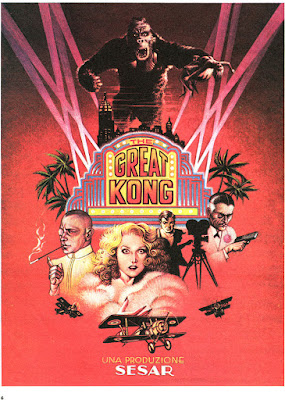Book Review: 'Montana Gothic' by Dirck Van Sickle
2 / 5 Stars
I first saw this book at the 'Too Much Horror Fiction' blog and, based on the brief blurb there provided, decided to read it.
‘Montana Gothic’ (254 pp) was first published in hardback in 1979; this Avon Books paperback was released in June, 1980. The artist who provided the striking cover illustration is uncredited.
The novel is organized into four Parts, each consisting of several chapters which progress through time, and are loosely linked by shared characters.
In Part One, it’s 1915, and Deke Morgan, grieving over a failed love affair, decides to move from Baltimore to Citadel, Montana (as best as I can tell, author Van Sickle uses fictional locations, or those of ghost towns, throughout the book), there to take over as the town’s undertaker. Morgan is depressed by the mud, cold, and isolation of small-town Montana. Then he discovers that the actions of the former undertaker have made the entire town loathe and detest the undertaker’s services……….
In Part Two, set about 50 years later, two cowboys – one a young man, the other an aged veteran – are working a small cattle herd in the wilderness. Within the cramped log cabin that is their refuge, they cope with the isolation and cold of the Montana Winter by playing cards and philosophizing.
In Part Three, also set ca. 1955, a mentally retarded young woman is caught up in a clandestine affair; her brother and father are left to deal with the consequences.
In Part Four, set in the 70s – 80s, a cowboy named Mavis Lambrook Herman roams the streets and sidewalks of Montana’s towns and cities, intent on staying true to the Code of the Frontier despite its obsolescence in the modern day.
I won’t disclose any spoilers, save to say that some of the characters in ‘Montana Gothic’ will be visited by tragedy and misfortune.
On the whole, ‘Montana Gothic’ was a disappointment. It’s devoid of supernatural or horror elements, relying instead on black humor to inform its expositions on human frailties. There is an earnest effort to make Montana the real ‘character’ underlying the events in the novel, but too often these efforts are related in a purple prose that quickly becomes tedious, and does little except pad the narrative.
It doesn’t help matters that Van Sickle’s handling of dialogue is less than impressive; for example, in the chapter ‘Winter Calf’, there are lengthy sections of conversation related in a labored ‘Homespun Frontier Wisdom’ dialect:
Montana, she ain’t fer sale, it’s free, but ya gotta love ‘er enough ta find it in yerself. She ain’t no whore.
This stuff is a pain to read. In later chapters, the conversations adopt modern forms of speech, but even here, Van Sickle’s dialogue is stilted and unconvincing.
My recommendation ? ‘Montana Gothic’ has its moments, but they are too few and far between to justify wading though the bulk of this novel.





















































































